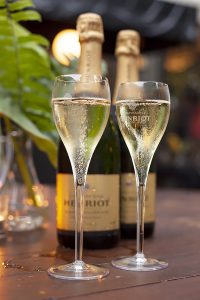Last week we argued Champagne was a poor choice for a wedding reception. Too many people, too high prices, too much cacophony to appreciate expensive French bubbles.
Champagne has a place. Consider it for an intimate honeymoon meal. Consider it for an anniversary tête-à-tête. Consider it when you want to treat yourselves to a special episode just because you can.
While Champagne makers insist their product is more than just a special-time tipple, for most of us opening a wine that costs triple digits automatically makes it a special event. So what is Champagne? There are specific rules and production methods that make it what it is and why it costs what it does.
Start with location. Champagne is exclusive to the chalk-and-clay soils of France’s Champagne region centered around the city of Reims, about 90 miles east, slightly north of Paris. Legislation defined the production zone in 1927. It encompasses about 132 square miles, 319 villages. Nearly 280,000 plots are tended by more than 16,000 growers. Most plots are about the size of a tennis court.
Myriad plots create a mosaic of individual terroirs, giving Champagne makers a rich, diverse palate of grapes. Champagne can only be made using three grapes: chardonnay, pinot noir, and pinot meunier, although very limited quantities of other varieties are allowed in rare instances.
Makers must employ méthode traditionnelle where the second fermentation—the fermentation that produces CO2 bubbles—is in the bottle that you eventually buy. Non-vintage bottles must age a minimum of 15 months in the bottle; many Champagne houses age longer. Vintage-dated bottles must age a minimum of three years; many houses age longer.
Champagne is the most expensive sparkling wine. Elaborate and lengthy production protocols contribute to Champagne’s pricing. Vintage-dated bottles start at $60-80. Prestige bottles have sold for as much as $2 million. Ultra high-end examples sell for $275,000. A bottle of Perrier-Jouët, 1874 vintage, sold for $57,000, the record amount at Christie’s. You can buy a bottle of Dom Perignon Brut Rosé 2005 online for $2,500-$3,500. Everyday bottles sell for $125-$300-plus.
Champagne costs as much as it does because it is excellent wine, time-consuming to make, rare in the highest quality tiers, and—most importantly—because Champagne drinkers are willing to pay. All of which is why I recommended you pour less-expensive sparkling at your raucous post-matrimonial-vows shindig. Save Champagne for the times and places you can really appreciate it.
Last round: Marriage is a union between a person who never remembers anniversaries and another person who never forgets them. Wine time.


